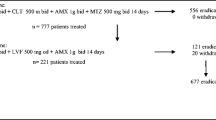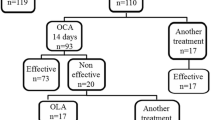Abstract
Aims
Our aim was to assess, in obese patients undergoing Roux-en Y gastric bypass surgery, the bismuth quadruple therapy (BQT) eradication rates at the first-line Helicobacter pylori (Hp) treatment as proposed by the Maastricht V/Florence consensus in areas with high clarithromycin (CLT) resistance rates–10 days proton pump inhibitor bid and three-in-one single capsule bismuth therapy containing bismuth, metronidazole, and tetracycline, marketed as Pylera four times a day.
Methods
This is a single-center prospective study over a 3-year period. Endoscopy and Hp assessment by histology was performed at baseline, and posttreatment Hp status was assessed by C13 urea breath test 4–6 weeks after the end of therapy. Data analysis was performed using the IBM® SPSS® Statistics 28.0 (IBM Corp. 2021, Armonk, NY) using mostly nonparametric comparisons (α = 0.05).
Results
The study cohort consisted of 598 adult obese Hp-positive patients [476, 78.6% female, age 43.2 (± 10.4) years] consecutively scheduled for Hp eradication therapy. Hp was eradicated in 500 patients [83.6.3% (95% CI: 80.4%–86.5%)], and the eradication was independent of gender, age, endoscopic diagnosis, and smoking status (p > 0.05).
Conclusion
Ten days of BQT did achieve Maastricht V/Florence recommended first-line eradication rates (at least 80%) in obese Portuguese patients undergoing Roux-en Y gastric bypass, being by now the most reliable choice for Hp eradication.
Graphical Abstract

Similar content being viewed by others
Data Availability
The data that support the findings of this study are available from the corresponding author, (Cerqueira RM), upon reasonable request.
Change history
04 March 2024
A Correction to this paper has been published: https://doi.org/10.1007/s11695-024-07062-2
References
Quina M, Guerreiro A. Gastric cancer (carcinoma) and Helicobacter pylori: situation in Portugal. Hepato Gastroenterol. 2001;48:1565–8.
Ferlay J, Autier P, Boniol M, et al. Estimates of cancer incidence and mortality in Europe in 2006. Ann Oncol. 2007;18:581–92.
Mathers CD, Loncar D. Projections of global mortality and burden of disease from 2002 to 2030. PLoS Med. 2006;3:e442.
Global, Regional, and National Cancer Incidence, Mortality, Years of Life Lost, Years Lived With Disability, and Disability-Adjusted Life-Years for 29 Cancer Groups, 1990 to 2017: A systematic analysis for the global burden of disease study. Global Burden of Disease Cancer Collaboration, et al. JAMA Oncol. 2019 (5): 1749–1768
Rasssmussen J, Fuller W, Ali MR. Marginal ulceration after laparoscopic gastric bypass: an analysis of predisposing factors in 260 patients. Surg Endosc. 2007;21:1090–4.
Gill KR, McKinney JM, Stark ME, et al. Investigation of the excluded stomach after Roux-en-Y gastric bypass: the role of percutaneous endoscopy. World J Gastroenterol. 2008;14:1946–8.
Silechia G, Catalano C, Gentileschi P, et al. Virtual gastroduodenoscopy: a new look at the bypassed stomach and duodenum after laparoscopic Roux-en-Y gastric bypass for morbid obesity. Obes Surg. 2002;12:339–48.
Orlando G, Pilone V, Vittiello A, et al. Gastric cancer following bariatric surgery. Surg Laparosc Endosc Percutan Tech. 2014;24:400–5.
Fried M, Hainer V, Basdevant A, et al. European Guidelines on surgery of severe obesity. Int J Obes. 2007;31:569–77.
Guidelines ASGE. Role of endoscopy in the bariatric patient. Gastrointest Endosc. 2008;68:1–10.
Malfertheiner P, Megraud F, O’Morain C, et al. Management of Helicobacter pylori infection. The Maastricht V /Florence Consensus Report. Gut. 2017;66:6–30.
Graham DY, Fischbach L. Helicobacter pylori treatment in the era of increasing antibiotic resistance. Gut. 2010;59:1143–53.
Boyanova L. Prevalence of multi-drug resistant Helicobacter pylori in Bulgaria. J Med Microbiol. 2009;58(Pt 7):930–5.
Katelaris P, Hunt R, Bazzoli F. World Gastroenterology Organisation Global Guidelines Helicobacter pylori May 2021. https://www.worldgastroenterology.org/guidelines
Mégraud F. H Pylori antibiotic resistance: prevalence, importance and advances in testing. Gut. 2004;53:1374–84.
Cerqueira RM, Correia MR, Vilar H, et al. How effective is the quadruple concomitant Helicobacter pylori eradication therapy for obese patients undergoing gastric bypass surgery? Obes Surg. 2016;26(6):1163–6. https://doi.org/10.1007/s11695-015-1920-3.
Lopo I, Libânio D, Pita I, et al. Helicobacter pylori antibiotic resistance in Portugal: systematic review and meta-analysis. Helicobacter. 2018;23(4):e12493.
Nyssen OP, Perez-Aisa A, Castro-Fernandez M, et al. European Registry on Helicobacter pylori management: single-capsule bismuth quadruple therapy is effective in real-world clinical practice. United Eur Gastroenterol J. 2021;9(1):38–46.
Author information
Authors and Affiliations
Corresponding author
Ethics declarations
Ethics Approval
Ethical Principles for Medical Research Involving Human Subjects is not applicable to our paper. This treatment is the Hp eradication standard of care. As the treatment was not prescribed as part of a clinical research trial, there was no need for study approval of the Hospital’s Ethics Committee (this is a real-world, nonintervention study with a standard of care therapy)—see “Patients and Methods.”
Conflict of Interest
The authors declare no competing interests.
Additional information
Publisher's Note
Springer Nature remains neutral with regard to jurisdictional claims in published maps and institutional affiliations.
Reprint requests are addressed to Rute Cerqueira, who is the guarantor of the article.
Key Points
There is a need for a Helicobacter pylori eradication protocol prior to bariatric surgery.
Maastricht V/Florence consensus recommends the first-line bismuth quadruple therapy in countries with high prevalence of clarithromycin resistance.
Helicobacter pylori eradication rate of 83.6% was achieved with ten days of bismuth quadruple therapy in line with the Maastricht V/Florence recommended goal of at least 80%.
Helicobacter pylori eradication was independent of patient’s age and gender.
Rights and permissions
Springer Nature or its licensor (e.g. a society or other partner) holds exclusive rights to this article under a publishing agreement with the author(s) or other rightsholder(s); author self-archiving of the accepted manuscript version of this article is solely governed by the terms of such publishing agreement and applicable law.
About this article
Cite this article
Maria, C.R., Rodriguez, C.M., Ines, P. et al. Bismuth-Based Therapy: The New Therapy for Obese Patients Undergoing Gastric Bypass Surgery?. OBES SURG 34, 123–127 (2024). https://doi.org/10.1007/s11695-023-06549-8
Received:
Revised:
Accepted:
Published:
Issue Date:
DOI: https://doi.org/10.1007/s11695-023-06549-8




